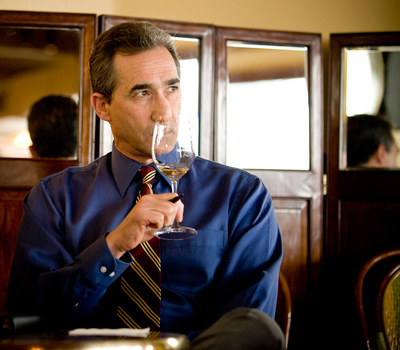Nestled in a chic barge docked along the bank in Brooklyn Heights, in the shadow of the ironworks of the Brooklyn Bridge, The River Café is one of New York’s longest-running restaurants. And Joe Delissio, who has determined what wines make it onto the barge since 1977, is one of New York’s longest-running wine directors. He’s completely changed his priorities since Hurricane Sandy took out his wine cellar in 2012, and recently told Josh Greene that he’s been selling ever-better values for the past three years.


In 2014, you reported that your average bottle price was between $80 and $120. In 2015, it was between $55 and $90. Where it is this year?
It slipped down a tiny bit; it’s probably between $50 and $90. The average has dropped a little lower but the high end is still at $90. People are looking for different ways to cut down—maybe on alcohol, and also on cost. I’ve seen a huge increase in half-bottle sales, an increase of between 30 and 40 percent. We’ve always had a lot of half bottles, but in the past six months, between five and ten percent of my sales have been half bottles; not only inexpensive wines, but most are on the lower side.
People think that wines by the glass have replaced half bottles, but a lot of places don’t have the best wines by the glass. A certain number of people would rather have a half bottle than wine by the glass. Maybe they think the quality would be better, and sometimes it is—you’re always assured of getting a fresh bottle.
Half-bottle sales have slightly diminished sales by the glass. But it’s harder and harder to find good half bottles. They’re out there. They usually have an upcharge, but the main reason producers give for not making them available—they say that they mature more quickly and sometimes they don’t sell… We’ve always had between 20 and 25 half bottles, that hasn’t changed. You’ve got to rotate them more quickly than the 750s. The La Rioja Alta Viña Ardanza, I fly through that stuff in half bottles. It’s not easy to find Bordeaux in half bottles, and it’s really hard to find Burgundy in half bottles.
Why is the Roederer Brut Premier so strong this year—right in the middle of your top-selling wines by the bottle and as well as your top by-the-glass selections?
People are drinking a lot more non-vintage Champagne, rather than vintage; non-vintage and rosé Champagne are getting more popular. People have gone from tête de cuvée to vintage and from vintage to NV. NV is 90 percent of our sales now; it was maybe was 80 or 75 percent in the past. I think that’s an economic thing. But Roederer at The River Café for $88, that’s cheaper than a lot of California chardonnay. Champagne has become a good deal. Remember, Champagne was always considered a luxury. Now Champagne and Chablis are the best white wine values, other than the typical things people talk about—Alsace and Germany. I myself never used to order Champagne on my buck, but now I do. If you compare it to so many different things, NV Champagne is a good value center.
After Hurricane Sandy, you had said you were cutting back on California cabernet. Is it coming back now, with Domaine Eden cabernet as your second best selling wine by the bottle, and Freemark Abbey cabernet as your second best selling wine by the glass?
My cutting back doesn’t mean that there’s not demand for it. It’s more about me saying, Is there a need for so many cabs? For the money, the Domaine Eden I would drink any time. And the Freemark is consistent—an old, established vineyard. I do sell a lot of cabernet by the glass, and a good amount of it by the bottle. But overall, we sell more California pinot noir than cabernet (well, it’s pretty close to being even).
We have the California Classics list that has all the older, rare things. On the basic list we have about eight cabs and a dozen or so pinots. Domaine Eden is that sweet spot ($77 a bottle). So is Freemark (at $22 a glass). And the two somms we have, they like the Domaine Eden, so when asked for a recommendation, they push it that way. The number of people who ask is probably about 35 percent.
How are you reshaping your list lately?
This past year, I took off all the California merlots; we don’t have a California merlot. I was having a hard time finding ones I liked. They seemed to serve no purpose—they tasted just like cabernets. It’s not like people are saying: Where’s the merlot? California couldn’t leave it alone. They color the wine so much the vineyard doesn’t show.
You have all these Spanish wines trying to be California cabernet; even Bordeaux is trying to be California cabernet. Red Bordeaux was always the king of red wine sales; we now sell five to one Burgundy to Bordeaux. That’s not a trend that started this year, but it’s increased this year. My next list is going to have more Burgundy and less Bordeaux.
A generational shift…
As far as the high alcohol wines, I came to the conclusion that the kids today who are drinking, they’re the same people who drink Bourbon and high-alcohol beer. They just like high alcohol. And they have no interest in putting things away. People don’t understand those mature flavors and don’t want them anymore. Everyone would rather have a wine right out of high school and they don’t care about letting it go to grad school. The more recent two generations following us, they have no patience; they just want the instant gratification thing. Recently I had a bottle of 1999 Ausone—that was lovely wine. But they’re not making wines like that and people don’t want them.
Joshua Greene is the editor and publisher of Wine & Spirits magazine.
















